Women Marines 1943 World War - Present Service Winter "A" Service Uniforms
Year: 1943
1943

This uniform originally belonged to Master Technical Sergeant Katherine Gail Kane.
Year: 1946
1946


Above the right pocket, formally called the Honorable Service Lapel Patch. Pictured is Marian King with her patch.
Year: 1952
1952
A new designed by Mainbocher was introduced that replaced the khaki tie to an ascot-shaped forest green necktie.
Year: 1958
1958
 In 1958 The Marine Corps introduced crossed rifles on it's rank structure. A new rank added to the USMC rank structure, Lance Corporal
In 1958 The Marine Corps introduced crossed rifles on it's rank structure. A new rank added to the USMC rank structure, Lance Corporal
Year: 1974
1974
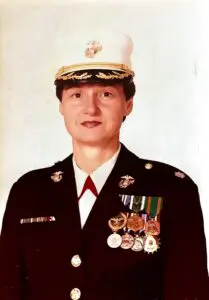
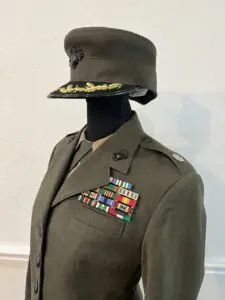
LtCol Mary V. (Ginger) Jacocks served on active duty December 1974 - August 1997
Year: 1980
1980
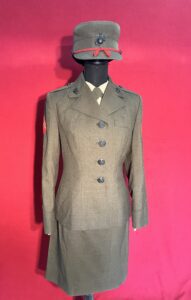
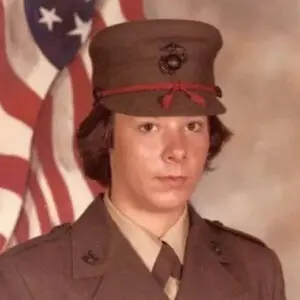
This uniform originally belonged to Corporal Robin K. Sasser.
1943 Service Alphas Uniforms “Winter” A
This uniform mirrored that you wone by all male Marines in color and style but was cut from a lightweight cloth.
This service uniform has notched lapels, and four (actual) slash pockets, sleeves finished with traditional “Marine Cuffs” and is fastened by three dull-bonze standard Marine buttons. The Master Technical Sergeant rank insignia does not display cross rifles.
This uniform virtually unchanged, except removal of pockets and material uniform was made from.
Service uniform was a forest green, worn with a long sleeve khaki shirt, tie, cap, brown shoes and gloves, and bronze metal buttons completed the outfit.
Worn with the long-sleeve khaki shirt with four-in-hand necktie, green cap, brown shoes, gloves, and bronze metal buttons completed the outfit.
All women Marines were required to maintain a plain black goloshes, boots, or rubber to fit the oxfords.
Uniform normally worn when reporting for duty, unless otherwise prescribed by commander.
This uniform originally belonged to Master Technical Sergeant Katherine Gail Kane. No other additional history/information is known.
The "Ruptured Duck" was given to those members of the U.S. military who were honorably discharged during WWII. The insignia was worn on the right chest of the uniform between 1939-1946 was meant to identify those who had completed active duty. The uniform with patch was authorized to be worn 30 days following discharge.
More information on Marian King Champagne
(September 10, 1919 - March 16, 2016)
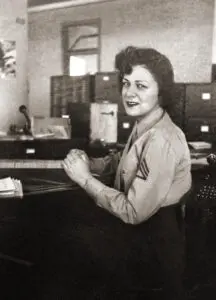
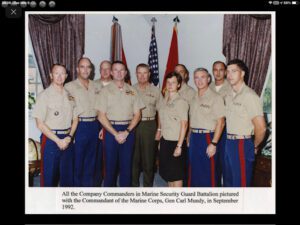
Biographical Information – Mary V. (Ginger) Jacocks
LtCol USMC (Ret)
Civilian Education – BA in Health, Physical Education, & Recreation (May 1972)
MA in Physical Education with Physiology of Exercise Emphasis (Dec 1974)
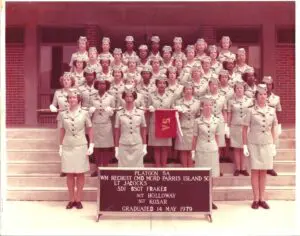
Completed Woman Officer Candidate School and Commissioned 2d/Lt – Dec 1774
Assigned 0202 (MAGTF Intelligence Officer) MOS upon completion of TBS
Military Education – Naval Air Intelligence Officer Course
MAGTF Intelligence Officer Course
Amphibious Warfare School (Nonresident)
Post Graduate Intelligence Program, DIA
Marine Corps Command and Staff College
Marine Corps War College
Military Assignments
II MAF/HQ FMFLant, Norfolk VA – G-2 Analyst and OIC, Photo Imagery Interpretation Team
(Mar 1975-Jul 1978)
Woman Recruit Training Command, Parris Island, SC – Series Commander and S-3 (Jul 1978-Jul 1982) – Designed and supervised construction of the Circuit Course at WRTC; over saw
implementation of first POI to include field training for enlisted women Marines
3d FSSG, Okinawa, Japan – AC/S, G-2 (Jul 1983-Jul 1984)
Development Center, Quantico, VA – Head, Treat Analysis Branch (Aug 1984-Jul 1987)
10 th Marine Regiment, Camp Lejeune, NC – S-2 (first female officer assigned to a combat support operational billet at the regimental level) (Aug 1988-Aug 1990)
2d FSSG, Camp Lejeune, NC – AC/S, G-2 (Aug 1990-Aug 1992)
Operations Desert Shield/Desert Storm – AC/S, G-2, Direct Support Command,
providing direct combat service support forward for the 1 st and 2d Marine Divisions (Dec
1990-Jun 1991)
J-2 and Asst J-2 of original JTF GTMO tasked with providing humanitarian relief and
security for the Haitian refugees fleeing their country (Nov 1991-Mar 1992)
Commanding Officer, Company A, Marine Security Guard Battalion, headquartered in Frankfurt,
GE (Aug 1992-July 1994) – responsible for Marine Security Guards at US Embassies and
Consulates throughout Russia, former Warsaw Pact, Yugoslavia (as it disintegrated), Greece,
Turkey, Austria, Germany, and Finland. (First female to command a MSG Company)
Student, Marine Corps War College (First female student)
Faculty Advisor and Intelligence Instructor, Marine Corps Command and Staff College (First
female Faculty Advisor at Marine Corps CSC)
Retired 1 August 1997 as a LtCol
Post USMC retirement:
First of two Regional Coordinators for Marine Corps University College of Continuing Education
(located at Cherry Point, NC) (Nov 1997–July 2000)
Intelligence and Opposing Forces Simulation Analyst, Instructor/Controller, and Exercise Planner at the II MEF Simulation Center, Camp Lejeune, NC (Aug 2000–Mar 2008) – (Part time capacity
Mar 2008-present)
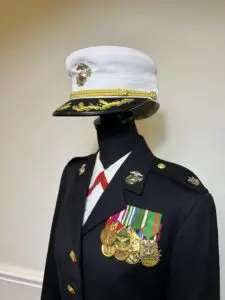
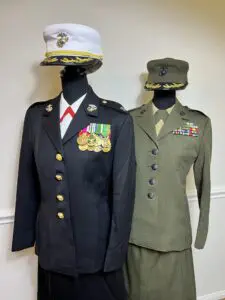
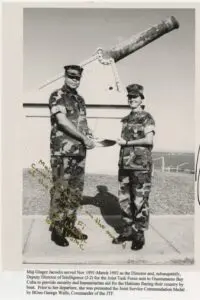
Corporal Robin K. Sasser
Served 1979-1982.
16 Apr 1979 - 11 Jun 1979 Graduated with Platoon 7A
23 Jun 1979 – 23 Jul 1979 MOS Training – Meridian, MS, Maintenance Admin
02 Aug 1979 – 30 Sep 1980 MWHS-3 @ El Toro, CA - Headquarters for the 3rd Marine Airwing.
02 Oct 1980 – 30 Jun 1981- HMS-16 @ Tustin, CA
01 Jul 1981 – 09 Apr 1983 - HMM 164 @ Tustin, CA - CH46 Sea Stallion Helicopters
September 1981 – March 1982 - Okinawa, Japan (Futema Base) Deployment
The "Ruptured Duck" was given to those members of the U.S. military who were honorably discharged during WWII. The insignia was worn on the right chest of the uniform between 1939-1946 was meant to identify those who had completed active duty. The uniform with patch was authorized to be worn 30 following discharges.
More information on Marian King Champagne
(September 10, 1919 - March 16, 2016) Pending

In picture Julia Estelle Hamblet, third director of the Women’s Reserve, wears the Summer white Uniform.
Julia Estelle Hamblet was born on May 12, 1916, in Winchester, Massachusetts to Martin and Marcia Coburn Hamblet, as the youngest of three children and the only daughter. She attended Hartridge School in New Jersey and then Vassar College in New York, graduating in 1937 with a bachelor’s in economics. She earned a master’s degree in Public Administration from Ohio State University in 1951.
After she graduated from Vassar College, Hamblet worked with the U.S. Information Service in Washington D.C. from 1937 to 1943. In April 1943, following her brother’s footsteps, she joined the military, signing up to the United States Marine Corps and was assigned to the first Marine Corps Women’s Reserve Officer Training Class at Mt. Holyoke, Massachusetts. She completed her training on May 4, 1943 and commissioned as a First Lieutenant in the Women’s Reserve.
During her tours of duty, she served at Camp Lejeune, Camp Pendleton, and Quantico. Before the end of World War II, she was commanding around 2,6000 women in the Aviation Women’s Reserve Group I, at the Marine Corps Air Station, Cherry Point, North Carolina. She was awarded a Letter of Commendation with Commendation Ribbon for her service during this period.
Although Hamblet was released from in July 1946, just two months later she was recalled to Headquarters Marine Corps in Washington, D.C. to succeed Katherine A. Towle and serve as a Major as the third director of the Women’s Reserve. Her time as Director would last from September 1946 to November 1948. The same year her term as Director ended, the Women’s
Armed Forces Integration Act was passed moving the Women’s Reserve into a regular component of the Marine Corps and name the Women Marines. On November 4,1948, Hamblet accepted a commission as Major in the Women Marines and in August 24, 1949 she was promoted to Lieutenant Colonel.
In 1951, she was assigned as staff of the commander, Fleet Marine Force, Pacific, headquartered in Hawaii and in 1952, she was named Officer in Charge of the Women Officers Training Detachment, Marine Corps Schools, Quantico.
On May 1, 1953, she once again succeeded Colonel Towle, who was retiring, as Director of Women Marines and moving up in rank as Colonel serving as Director until March 1, 1959. She served as the longest and youngest Director of Women Marines. Later that same month, she was assigned duty in Naples, Italy, as military secretary to the Commander-in-Chief, Allied Forces, Southern Europe.
In May 1962, upon her return from Italy, she reported to the Marine Corps Recruit Depot, Parris Island, as commanding officer, Women’s Recruit Training Battalion, and served in this capacity until her retirement three years later on May 1, 1965.
Upon retirement, she was awarded the Legion of Merit for “outstanding service as planner, administrator and leader of Women Marines throughout a distinguished career which encompassed every major assignment in the women’s program…”. Col Hamblet was instrumental in opening active duty military to women instead of only having access to the reserve components.
During her retirement, Hamblet did volunteer work with the American Red Cross and the YWCA.
On April 17, 2017, at the age of 100, Hamblet passed away, in Williamsburg, Virginia.
The below is worn with yellow neck tab.
Lieutenant Colonel Rhonda LeBrescu Amtower, retired from the U.S. Marine Corps in January 2001 after 25 years in the intelligence field.
She enlisted in the Marine Corps in January 1976 and attended the 47-week basic course in Chinese Mandarin at the Defense Language Institute in Monterey, California. She applied for and was accepted into the Enlisted Commissioning Program. In August 1977, she was assigned the MOS of Basic Intelligence Officer. She also held the additional MOS’s of Imagery Officer, Chinese Foreign Area Officer and Joint Service Officer.
Her early assignments within the Intelligence field include: Imagery Officer at the Fleet Intelligence Center Pacific from 1978-1981; Officer in Charge of the Force Imagery Interpretation Unit with the First Marine Aircraft Wing in Okinawa, Japan from 1981-1982; Officer in Charge of the Marine Detachment, Naval Intelligence Support Center, Suitland, Maryland from 1983-1985.
She was selected as the first female Marine officer to serve in the Defense Attaché program and spent the next two years as the Assistant Naval Liaison Officer in Hong Kong. She served as the MAG-16 Intelligence Officer in Tustin, California from 1988-1990. Her next assignment was as the Executive Officer of the Fourth Recruit Training Battalion at Parris Island, South Carolina from 1990-1992. She then attended the Marine Corps Command and Staff College and served a two-year joint tour with the Combined Forces Command/ U.S. Forces Korea as the Intelligence Exercise Planner. Her next assignment was in Camp LeJeune, North Carolina where she served as the II MEF G-2 Operations Officer from 1995 until her last assignment to Headquarters Marine Corps, Intelligence Department in August of 1998 to January 2001.
Her personal awards include the Defense Meritorious Service Medal, Meritorious Service Medal (2nd Award), Joint Service Commendation Medal, Navy Commendation Medal, Joint Service Achievement Medal, and the Navy Achievement Medal.
Rhonda joined the Women Marines Association (WMA) in 1989 while stationed in Tustin, California and is a life member of National and of the local DC-l Chapter. She has served in several positions before assuming the position of National President from 2008 to 2012. In 2018 she once again assumed the position as the WMA National President and will continue to serve until the end of the 2020-2022 term of office.
She is married to James (Jim) Amtower LCDR USN (Retired) and they live in Williamsburg, Virginia.
The service summer uniform consisted of two-piece including a blouse and skirt made of green and white striped material, originally Plisse Crepe but later replaced by Seersucker. (A thin, puckered, all-cotton fabric, commonly striped and very common for summer clothing.)
The jacket had shoulders straps of same material, each fastened by a single button. Buttons for the jacket were white bone or composite.
Headwear for the summer service uniform was initially the Service “Bucket” cover, which was replaced in 1944 by the Summer Garrison Cap.
The handbag was the spruce green cover and shoulder strap.
The service summer uniform consisted of a two-pieces including a blouse and skirt made of green and white striped material Seersucker. (A thin, puckered, all-cotton fabric, commonly striped and very common for summer clothing.)
The jacket had shoulders straps of same material, each fastened by a single button. Buttons for the jacket where green compose with standard Marine eagle/anchor facing.
When realized that officer rank insignia was hard to see on the shoulder strap, officers where authorized to wear shoulder boards of spruce green material fastened by the shoulder strap button and by the rank insignia at the shoulder.
Headwear the Summer Garrison Cap and Summer Service “B” and “C” the Green Cover.
The handbag was spruce green cover and shoulder strap
In 1952, the service summer uniform was a one-piece dress uniform with its band at the waist.
Made of nylon-dacron-cotton. The dress, skirt, and cap had to match.
The jacket had shoulders straps of same material, each fastened by a single button. Buttons made of green compose with standard Marine eagle/anchor facing.
Washing ease and wrinkle free resistance were the chief features of the new summer fabric.
Unfortunately, the fabric became scarce and expensive, and the Marine Corps had to consider a material shared by the other services since the bulk ordering reduced the price.
The handbag was black with black straps.
In 1966, an entirely new two-piece dress made of the same polyester-cotton, corded, green-and-white striped material was approved. Recruits began to receive it in July 1967.
The Summer Garrison Cap was still the headgear but in 1966 the Summer Service “B” and “C” consisted of wearing the Green “bucket” Cover.
Another change involving summer uniforms was seen in 1966 when women officers were authorized to wear the summer dress cap, a bright green version of the winter service and dress blue cap, as an optional item when on leave or liberty. When worn with summer uniform, bronze buttons and insignia were worn rather than gilt buttons and dress insignia. Field grade officers, if they elected to wear the dress cap with the service uniform, were required to wear one with a plain visor, without gold embroidery.
In 1969 the long sleeve blouse with a skirt became available. The regulations were broadened and officers could wear the dress cap on an everyday basis except when in formation. This privilege was extended to staff noncommissioned officers in 1971.
 Sergeant Robin K. Sasser Served 1979-1982. 16 Apr 1979 - 11 Jun 1979 Graduated with Platoon 7A 23 Jun 1979 – 23 Jul 1979 MOS Training – Meridian, MS, Maintenance Admin 02 Aug 1979 – 30 Sep 1980 MWHS-3 @ El Toro, CA - Headquarters for the 3rd Marine Airwing. 02 Oct 1980 – 30 Jun 1981- HMS-16 @ Tustin, CA 01 Jul 1981 – 09 Apr 1983 - HMM 164 @ Tustin, CA - CH46 Sea Stallion Helicopters September 1981 – March 1982 - Okinawa, Japan (Futema Base) Deployment
Sergeant Robin K. Sasser Served 1979-1982. 16 Apr 1979 - 11 Jun 1979 Graduated with Platoon 7A 23 Jun 1979 – 23 Jul 1979 MOS Training – Meridian, MS, Maintenance Admin 02 Aug 1979 – 30 Sep 1980 MWHS-3 @ El Toro, CA - Headquarters for the 3rd Marine Airwing. 02 Oct 1980 – 30 Jun 1981- HMS-16 @ Tustin, CA 01 Jul 1981 – 09 Apr 1983 - HMM 164 @ Tustin, CA - CH46 Sea Stallion Helicopters September 1981 – March 1982 - Okinawa, Japan (Futema Base) Deployment
The standardization of uniforms by the four services resulted in a common blue uniform utility outfit, dark blue slacks, cap, and sweater, and a light blue shirt. Recruits received the new blue utilities in July 1967 and the green ones where not permitted after July 1971. The new uniform while more feminine in appearance, was never truly accepted.
Black insignia of service was worn on the blue cap but the dark color lacked contrast and the gold emblem was adopted on the utility cap in 1970. In 1977, the wearing of male camouflaged field uniform was authorized. The boots replaced the black oxfords and cushion-sole socks took place of anklets.
In 1977, wearing of male camouflaged field uniforms (cammies) by all women Marines was approved. In 1979 the production of the utility camouflage in smaller sizes to be issued to women Marines began.
Combat boots replaced oxfords and cushion-sole socks took the place of anklets for Women Marines.
This uniform originally belonged Mary Ortiz-Dvorak, picture below.
Sgt Mary E Dvorak
August 1977 – September 1983 Platoon 11-A
6 Aug 1977 – 3 Oct 1977
MOS 3531 Heavy Vehicle Operator
Oct 1977 – Jun 1980
Base Motor Transport, Camp Lejeune, NC Heavy Vehicle Dispatcher
Jun 1980 – Sept 1983
HqSvcCo, HqSvcBn, 3d FSSG, Camp Kinser, Okinawa
Chief of Staff driver and administrative support for Commanding General and Chief of Staff
Decorations:
Rifle Marksman Badge, Sea Service Deployment Ribbon (w/2*), Marine Corps Expeditionary Medal, Good Conduct Medal (w/1*), Letter of Appreciation, Meritorious Mast and Certificate of Commendation.
In 1977 General Wilson approved wearing of male camouflaged field uniforms (cammies) by all women Marines. In 1979 the production of the utility camouflage in smaller sizes to be issued to women Marines began.
Combat boots replace the Black Oxford‘s and cushion so socks took the place of anklets for women at work in certain jobs and then training.
This uniform originally belonged to This uniform originally belonged to Sgt Heidi Joan Larson.
Graduated Boot Camp Nov 1975. Selected as Molly Marine and Honor Grad for both platoons: 9A and 9B.
Her Duty station: Camp Pendleton, CA MOS Graphic Illustrator 4611 (4900 field first and changed).
Left active-Duty September 1978.
Entered the USMC Reserves at South Weymouth Naval Air Base as a PAO.
Attended college and graduated with a BFA in Design 1983 from Massachusetts College of Art and Design. Received Masters and Teaching certification and started teaching.
Reenlisted and assigned to Camp Lejeune in 1990 during the Gulf War Conflict. She was assigned her original MOS 4611.
MOS was being dissolved, there were NO promotions in field. Requested early release to return to teaching.
Has been teaching ART ever for 30th year in education
Her future plans are to retire as the Director of Art and Design from Braintree Public Schools June of 2022.
Combat boots replaced oxfords and cushion-sole socks took the place of anklets for Women Marines.
In December 1979, a camouflage utility uniform, referred to as “cammies,” replaced the blue utility uniform for women and green sateen utility uniform worn by men.
1980 - female enlisted Marine wearing the older-style poplin camouflage utilities.
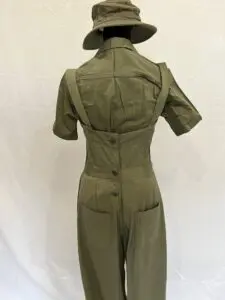
Overall – made from sage green cotton – Bib button to straps – worn with a white “skivvy shirt or the khaki shirt, utility, WR, under the utility coat.
Made from sage green cotton with bib button to straps. It worn with a white “skivvy shirt or either the khaki or utility shirt, under the utility coat.
Overalls have two rear open-top patch pockets and fastened at the back by four composite buttons. This was later changed to four-buttons side fastening on the left side.
Headwear was usually the utility cap utility, or a “Daisy Mae” hat made from the same sage green cotton. The hat was made from the same sage green cotton and had six-panel crown with a stich-reinforced brim and was usually worn with the brim turned up all around.
Overall uniform originally belonged S. I Savignad. No other additional history/information is known.
This uniform originally belonged to 1sSgt Frances A. Curwen, Retired.
Information on 1st Sergeant Frances A. Curwen (Bilski), Retired was retrieved from, A History of the Women Marines 1946-1977. No additional history/information is known.
Mail clerk from August 1943 until September 1946 at the fleet post office in San Francisco.
In 1949, former WR Staff Sergeant Frances A. Curwen was selected to be part of the Boston unit, one of the first seven WR platoons to be trained to meet mobilization needs of the Marine Corps. Designated women's Reserve platoons (WR platoons), were attached directly to the major parent male unit as an organic element (e.g., WR Platoon, 11th Infantry Battalion).
Mobilized for the Korean War, TSgt Curwen was the only female postmaster in 1952 and supervised the Montford Point Branch, Camp Lejeune Post Office. Following the war, she was a member of the VTU, and as an instructor at the Marine Corps East Coast Postal School in 1952.
On 19 January 1953, Technical Sergeant Curwen (later Bilski), hand selected to be an instructor, was an instructor for the first class of Staff NCO Leadership School for women since 1945. The Staff NCO Leadership School for women was convened Camp Lejeune.
In the early 1960s, after having served as postmaster at Parris Island, she was ordered to similar duty in Hawaii, but the command absolutely refused to have a woman in the job, saying that the mail bags were too heavy for a female.
In the late 1960’s, Gunnery Sergeant was one of many drill instructors. Picture below GySgt Curwen teaching a typing course in the early 1960s to recruits at Parris Island.
The exercise suit or “peanut suit” as it was commonly referred due to the light brown color and crinkled appearance, consisted of a one-piece “bloomer outfit” (shorts and blouse) in brown and white striped Seersucker material, buttoned down with six composite buttons.
The suit has a single open topped breast pocket on the left front panel. The suit was short-sleeved and had drawstring cuffs on the shorts (for modesty).
Later production suits had a removable skirt, made from the same material as the suit and buttoned down the front with seven composite buttons.
No information or history is known on who owned these uniforms.
Consisting of a pale green cotton broadcloth skirt waist shirt, skirt, and an ascot-shaped forest green necktie.
These uniforms display a uniform with and without the cross-rifles. The cross-rifles were not introduced until 1958.
In 1950 a new uniform was created/designed for the Director of Women Marine, Colonel Towle. This was added because the Director of Women Reserve did not have an evening uniform. In 1953 When Colonel Hamblet became Director of Women Marines a similar uniform was created. Between 1950 and 1964 only two evening dress uniforms were made.
In 1966 the dress mess became available to all officers. SNCO’s where not authorized wear of the dress mess until 1972. Mess Dress has remained unchanged other than the blouse no longer contains ruffles.
Officer Winter Dress: Women Marines did not have a dress blue uniform until 1952 . During World War II and the seven years following, officers turned the winter service uniform into a dress uniform by exchanging the khaki shirt for one of white and the khaki necktie for one of forest green. Enlisted women had no comparable dress outfit.
White mess dress uniforms for male officers first appeared in 1904 although blue mess jackets had been worn since 1875. The dark blue mess dress was redesignated as evening dress in 1922.
This uniform originally belonged to Colonel Michele Manning. (Picture and short biography provided.
Colonel (Reverend) Michele “Mitzi” Manning
(Originally from Washington D.C.)
In 1965 attended Eastern Michigan University, and taught school for 5 years after graduation. While attending a Master’s in Education at Winthrop College) was recruited for officer candidate school.
Reported for Marine Corps officer training at Quantico, VA on June 19, 1972.
For 27 years, she served on active duty with billets that included as a series officer at Parris Island, SC; adjutant at squadron, battalion, air station, and force level; Graduate Education Coordinator for the Marine Corps; head in MMOA, HQMC; CO, H&HS, MCAS Camp Pendleton; A/CofS G-1, MARFORPAC; Commander, Western Sector U.S. Military Processing Command, and finally as Secretary, The Joint Staff. She was retired as a Colonel on June 25, 1999 at one of the first retirements held at WIMSA, and CMC (General Chuck Krulak) was the presiding officer.
Attend Wesley Theological Seminary in Washington D.C., graduating in 2003. In 2002 she was given the position as Older Adult Minister at Fairlington United Methodist Church in Alexandria, Virginia.
In October 1980 a new blue dress uniform—including blue dress slacks—for female officers was announced. The new uniform was adopted to make female and male officer blue dress uniforms more compatible; the female coat and skirt were made of the same material as the male officer blue dress uniform.
This uniform originally belonged to MGySgt Deb Straight (Picture and short biography provided.
MGySgt Deb Straight
(Originally from Rotterdam, NY)
Graduated from Recruit Training in August 1974 with Platoon 5A. She served as Platoon Guide and was the platoon Molly Marine recipient.
Assigned as a 01, Administrative Specialist, she served her 29+ active-duty years.
MCAS Cherry Point (1973-1977); FMFPac Camp Smith HI (1977-1982).
HQMC (1982-1985).
1st MAW Okinawa (1985-1986).
FMFPac Camp Smith HI (1986-1989), SNCO Degree Completion Program (1990-1991) at SUNY Fredonia.
MCAS Cherry Point Family Service Center (1991-1994).
1st MAW (ASE/MALS-24) at MCBH, Kaneohe HI (1994-1998).
MISSO-27, MCB Camp Butler, Okinawa (1998-1999).
MARFORPAC, G-1, Camp Smith HI (1999-2003).
MGySgt Straight retired in Hawaii and is currently employed with the USAF.
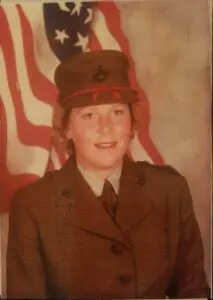
Maternity uniforms - from 1948 – 1970 Women Marine soon got pregnant had to be discharged.
The fall of 1971 headquarters announced it with memories who in their step parent or who had personal Cassidy or adopted a child could stay on active duty.
In 1971, pregnant women were permitted to remain in the military. Pregnant Marines could/would wear civilian clothes when uniform no longer looked appropriate.
In 1979 Marine Corps authorized the wear of this maternity uniform.
In 1971 in waiver policy for natural mothers was tested.
Gunnery Sergeant Francis ill Gonzalez what’s the first woman Marine to take advantage of the program, never missed the day of work other than annually.
In 16 July 1975, Women Marines who were pregnant, upon request, be discharged or retain or active duty if otherwise qualified.
Women Marines wore civilian clothes when do uniform no longer looked appropriate.
April 1979 a maternity uniform was approved. The maternity uniform con- sisted of an olive tunic top, slacks, and skirt.
--
Sgt Camille Miranda Venable
(Originally from North Tonawanda, NY)
Graduated from Recruit Training in October 1978 with Platoon 16B. MOS's 3073 (Computer Operator), 3072 (Aviation Supply Clerk) and 3043 (Supply Admin & Op's Clerk). Attended MOS schools in Meridian, MS in 1979.
Stationed at MCAS (H) Tustin, CA from 1979-1981.
July 1981 was transferred to Okinawa for 1 year, MCAS Futenma.
1982 was transferred to Camp Pendleton, CA and worked as the NCO-In-Charge for MIP-1 (Material Issue Point).
Wore this uniform at Camp Pendleton in 1985 while pregnant with first son.
After being discharges from active duty moved to the Dallas, TX area where she enlisted with the active Reserves at NAS Dallas until 1989, after the birth of our second son.
Has been with her current employer for 21 years and has continued to work in the Aviation field since her Marine Corps training.